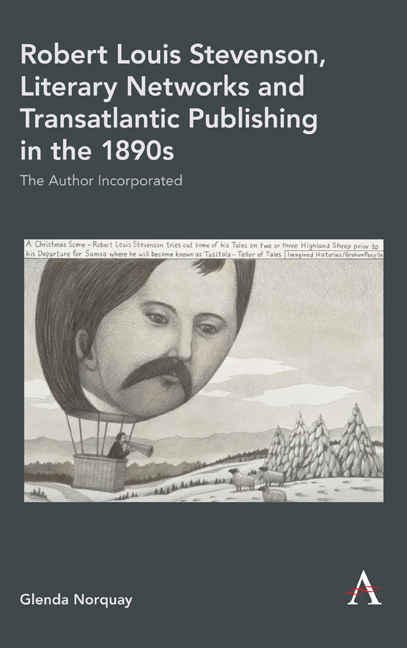 Robert Louis Stevenson, Literary Networks and Transatlantic Publishing in the 1890s
Robert Louis Stevenson, Literary Networks and Transatlantic Publishing in the 1890s Book contents
- Frontmatter
- Contents
- Acknowledgements
- Abbreviations
- Introduction
- 1 Lemuel Bangs: ‘The Senator’
- 2 A Tale of Two Texts
- 3 ‘A Gentleman Called Charles Baxter’
- 4 Sidney Colvin: Custodian and Monument
- 5 Family, Friends and Collaborators
- 6 Arthur Quiller-Couch: The Quivering Needle
- 7 Richard Le Gallienne: ‘Not While a Boy Still Whistles’
- Conclusion: Robert Louis Stevenson Incorporated
- References
- Index
2 - A Tale of Two Texts
Published online by Cambridge University Press: 16 February 2020
- Frontmatter
- Contents
- Acknowledgements
- Abbreviations
- Introduction
- 1 Lemuel Bangs: ‘The Senator’
- 2 A Tale of Two Texts
- 3 ‘A Gentleman Called Charles Baxter’
- 4 Sidney Colvin: Custodian and Monument
- 5 Family, Friends and Collaborators
- 6 Arthur Quiller-Couch: The Quivering Needle
- 7 Richard Le Gallienne: ‘Not While a Boy Still Whistles’
- Conclusion: Robert Louis Stevenson Incorporated
- References
- Index
Summary
At the time of his death in 1894 Stevenson was working on two very different novels, moving between them as his enthusiasm determined and health permitted. Friends in London saw St Ives, the Adventures of a French Prisoner in England, as a return to earlier adventure-fiction successes, promising muchneeded commercial rewards. Stevenson jested, ‘It would make money for a harmless fambly.’ He was also writing Weir of Hermiston, which he referred to as The Justice Clerk, set in the same period but tragic and intense. Working on St Ives was increasingly an unhappy experience; he had a more positive attitude to Weir. Weir remains critically recognized as significant; St Ives almost disappeared from sight. Connections between the two novels, however, are closer than Stevenson acknowledged and go beyond their shared timeframe. Both are in dialogue with Scotland's history and identity: one through a tragic romance echoing the border ballads, the other through picaresque adventure. While deploying the voices and landscapes of Stevenson's youth, Weir has been seen as a move to greater maturity in his writing. In St Ives Stevenson also revisits places tramped across in his younger days – those Scottish border scenes given literary endorsement by Scott and Hogg – but views them through the eyes of a French stranger. Weir extends a shift towards psychological intensity begun in his South Seas fiction. His increasingly ironic attitude to adventure emerges in St Ives through inflation of the genre's conventions.
In both novels Stevenson, who had been writing energetically and controversially about the South Seas, returned to a Scottish setting, writing with a distance that recontours it. During a period in which the shaping of cultural modernity emerged, with time and distance increasingly compressed, Stevenson was a writer who travelled extensively by train, boat and donkey. As Charlotte Mathieson suggests, modes of movement, experience of journeys and different types of travel generate meanings – social, cultural and geographic. Weir of Hermiston is a novel locked into a place and a specific time, yet its dialogue with the patterning of such landscapes – expressed through interest in the telling of tales and inscribing of history – gives it a temporal distance which suggests mobile authorial revisiting. St Ives oscillates in distance from its historical setting and adventure genre by its parodic knowingness. It also moves through time and space in more obvious ways: journeying across a nation, journeying through nationalities.
- Type
- Chapter
- Information
- Robert Louis Stevenson, Literary Networks and Transatlantic Publishing in the 1890sThe Author Incorporated, pp. 53 - 80Publisher: Anthem PressPrint publication year: 2020


